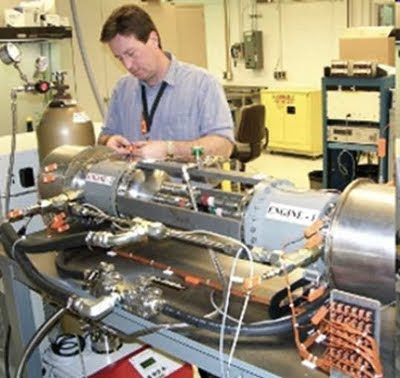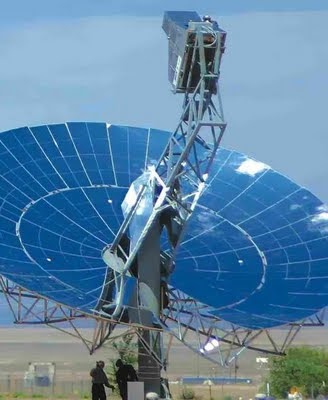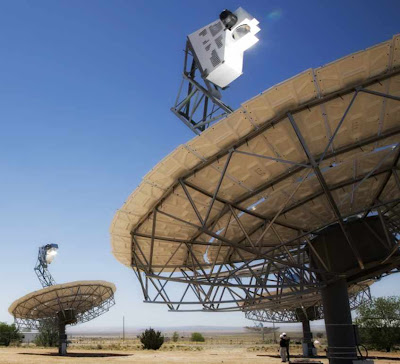.
Stirling Old
Stirling New
Stirling Powered
Stirling True
To wrap up my series of Stirling posts, I have gathered together a bit of a mishmash of interesting bits and pieces that I hope you will enjoy reading about.
Stirling Old
As a link to the past I have included this picture of a lovely old Stirling Rider engine made in the USA. These old heavy iron engines have become real collectors items these days and are lovingly restored to pristine levels by some very dedicated enthusiasts.
A Stirling Ireland ConnectionTom Bruton recently wrote and told me that Teagasc, the agriculture and food development authority in Ireland, are putting a Stirling based bio-mass generator in their Oakpark research headquarters in Carlow, Ireland. He also suggested going to
www.stirling.dk for more info about the machine they have bought.
I contacted StirlingDK, who have kindly have given me permission to use their materials and sent some interesting photos.
 Stirling DK what they say about themselves
Stirling DK what they say about themselvesBased on more than 15 years of solid research led by the leading authority within applied Stirling engine technology, professor Henrik Carlsen, Stirling DK has today materialized as the worlds' leading provider of biomass fuelled Stirling engine systems.
Our technology enables us to convert biomass of low value, such as wood chips and straw, into high value, clean, CO2-neutral electricity and heat. And we can do this in small-scale applications with an electrical output between 10 and 500 kWe. The heat is typically used for district heating but can also be used for other purposes such as freshwater generation, cooling, or process heating.
November 15th 2008 First Irish Contract The 35 Kilo Watt electrical output Stirling Engine by Stirling DK
The 35 Kilo Watt electrical output Stirling Engine by Stirling DKA contract has been signed for the delivery of a 35 kWe /1480 kWth updraft gasifier plant to be delivered to National Research Institute (NRI) of Ireland.
 A Handy sized Engine don't you think?
A Handy sized Engine don't you think?The plant will be fuelled by wood chips and the heat will be used for heating of buildings of the NRI . The power, which will be generated by one (1) 35 kWe SD3-E engine, will be sold to the electrical grid.
The updraft gasifier will have a capacity of 800 kW and the installation is therefore prepared for the possible later expansion by addition three 35 kWe engines. The total electrical output of the plant can thus reach 140 kWe.
This will become Stirling DK's first installation in Ireland. This market is considered to be very attractive due to Ireland's large biomass resources and strong focus on CO2-neutral energy productions.
The plant will go into operation in May 2009.
Meccano and The Fab Lab I am not sure where this picture originates,
I am not sure where this picture originates,
I just love the practical hands-on test rig!!Don't you just love this bit of experimental engineering!! When I was a kid 50 years ago!!! I had a great love of Meccano sets and hoped I would get one each birthday and Christmas. The guys at this lab have evidently held on to their Meccano sets, along with their mother's cake mixing bowl, and used them to rig the above test rig. Just the way I love science.
Stirling on the Moon and Mars Moon photo by Biorn McGinley
Moon photo by Biorn McGinleyNASA has marked Stirling power conversion using the heat from fissionable material as a viable option for generation of power on the moon. They have been playing around with using a Stirling converter coupled to a relatively low-temperature < 900K, uranium dioxide fuelled, liquid-metal-cooled reactor. A similar configuration is being worked on for application on Mars.
 Stirling and the Nuke
Stirling and the Nuke The project is being developed at the Foster Miller and Auburn University; the aim is to design and fabricate a 5kW Free-Piston Stirling converter.
Long live Stirling!I hope you have enjoyed reading the series of Stirling posts half as much as I have enjoyed researching and writing them.
With much thanks to the Rev. Robert Stirling, who's memory will live long into the future!
Tapadh leibh Robert Stirling agus Alba!!
 .
.























